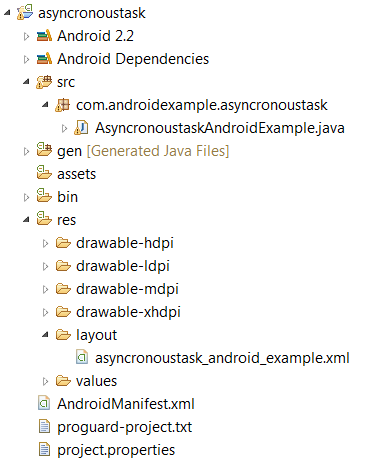1. AsyncTask provide easy way to use of the UI thread.
2. Perform background operations and publish results on the UI thread without having to manipulate threads and/or handlers.
3. AsyncTask is designed to be a helper class around Thread and Handler and does not use a generic threading framework.
4. AsyncTasks should ideally be used for short operations (a few seconds at the most.)
5. The AsyncTask class must be loaded on the UI thread.
6. The task instance must be created on the UI thread.
7. execute(Params...) must be invoked on the UI thread.
Taking same example as we have done in previous example Thread With Handlers - Android Example
In this example we are creating a thread and call http GET method to get server response and after got the response,then do other functionality ( Save Data in database or show alert ,Redirect to another activity).

Create button refference:
final Button GetServerData = (Button) findViewById(R.id.GetServerData);
On Botton click:
Inside button click listener create LongOpertion Object and call excecute method
GetServerData.setOnClickListener(new OnClickListener() {
public void onClick(View v) {
// Server Request URL
String serverURL = "/media/webservice/getPage.php";
// Create Object and call AsyncTask execute Method
new LongOperation().execute(serverURL);
}
});
onPreExecute() Method :
After call execute() method onPreExecute() will call and show dialog.
Inside onPreExecute() we can update UI elements.
protected void onPreExecute() {
// NOTE: You can call UI Element here.
//UI Element
uiUpdate.setText("Output : ");
Dialog.setMessage("Downloading source..");
Dialog.show();
}
doInBackground(String... urls) Method :
Just after complition of onPreExecute() method doInBackground() will call
Inside doInBackground we will take background processing ( Request to server )
NOTE : Inside doInBackground() we can not update UI elements.
// Call after onPreExecute method
protected Void doInBackground(String... urls) {
try {
// Call long running operations here (perform background computation)
// NOTE: Don't call UI Element here.
// Server url call by GET method
HttpGet httpget = new HttpGet(urls[0]);
ResponseHandler<String> responseHandler = new BasicResponseHandler();
Content = Client.execute(httpget, responseHandler);
} catch (ClientProtocolException e) {
Error = e.getMessage();
cancel(true);
} catch (IOException e) {
Error = e.getMessage();
cancel(true);
}
return null;
}
onPostExecute() Method :
Just after doInBackground() method processed ( Done all background tasks ) , onPostExecute method call.
Inside onPostExecute() we can update UI elements.
protected void onPostExecute(Void unused) {
// NOTE: You can call UI Element here.
// Close progress dialog
Dialog.dismiss();
if (Error != null) {
uiUpdate.setText("Output : "+Error);
} else {
uiUpdate.setText("Output : "+Content);
}
}
public class AsyncronoustaskAndroidExample extends Activity {
/** Called when the activity is first created. */
@Override
public void onCreate(Bundle savedInstanceState) {
super.onCreate(savedInstanceState);
setContentView(R.layout.asyncronoustask_android_example);
final Button GetServerData = (Button) findViewById(R.id.GetServerData);
GetServerData.setOnClickListener(new OnClickListener() {
public void onClick(View v) {
// Server Request URL
String serverURL = "/media/webservice/getPage.php";
// Create Object and call AsyncTask execute Method
new LongOperation().execute(serverURL);
}
});
}
// Class with extends AsyncTask class
private class LongOperation extends AsyncTask<String, Void, Void> {
private final HttpClient Client = new DefaultHttpClient();
private String Content;
private String Error = null;
private ProgressDialog Dialog = new ProgressDialog(AsyncronoustaskAndroidExample.this);
TextView uiUpdate = (TextView) findViewById(R.id.output);
protected void onPreExecute() {
// NOTE: You can call UI Element here.
//UI Element
uiUpdate.setText("Output : ");
Dialog.setMessage("Downloading source..");
Dialog.show();
}
// Call after onPreExecute method
protected Void doInBackground(String... urls) {
try {
// Call long running operations here (perform background computation)
// NOTE: Don't call UI Element here.
// Server url call by GET method
HttpGet httpget = new HttpGet(urls[0]);
ResponseHandler<String> responseHandler = new BasicResponseHandler();
Content = Client.execute(httpget, responseHandler);
} catch (ClientProtocolException e) {
Error = e.getMessage();
cancel(true);
} catch (IOException e) {
Error = e.getMessage();
cancel(true);
}
return null;
}
protected void onPostExecute(Void unused) {
// NOTE: You can call UI Element here.
// Close progress dialog
Dialog.dismiss();
if (Error != null) {
uiUpdate.setText("Output : "+Error);
} else {
uiUpdate.setText("Output : "+Content);
}
}
}
}